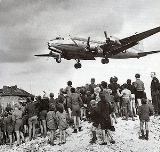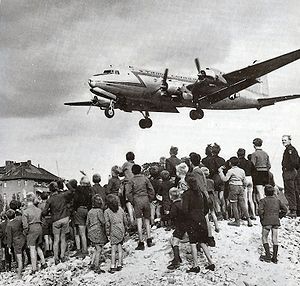
Henry Ries
Encyclopedia
Henry Ries was a photographer who worked for New York Times. His most famous photo was of "The Berlin Air Lift" which was later made into a U.S. Postage Stamp
commemorative
.
 Ries was born in Berlin
Ries was born in Berlin
and grew up in Germany
, but sensed the impending doom of Hitler's political style and, as a Jew, emigrated to the United States in 1937. Immigration officials in New York
sent him back to Nazi
Germany because of technical problems with his papers. Fortunately, Ries was permitted to enter America in January 1938, having crossed the Atlantic twice to do so.
When America entered World War II
, Ries immediately joined the army and fought in the Asian Theater
, humorously pointing out that he served in Asia due to his "good German" skills. He was stationed in India
with an aerial reconnaissance unit. After the war, in August 1945, Ries, still a soldier, returned to Berlin. He soon resigned from the army in order to work for the OMGUS Observer as a photojournalist. Two years later, he begin to work for The New York Times
as a European photographer, photographing many of the scenes of destroyed post-war
Germany including the destruction and Berlin blockade which have become iconic images. In 1951, Ries returned to the US and eventually turned to commercial photography. In 1955, he opened his own studio in Manhattan
.
When he returned to Berlin in 1945, he pronounced the city forever changed. In his book, Abschied meiner Generation, he said, "Seeing all this devastation and desperation, confronted with hunger and fear, cripples and black-marketers – and with no Nazi in sight anywhere – I realized how fundamentally the seven years between emigration and occupation had changed Germany's exterior and my own interior."
During his time with the Times, he met and photographed the famous and the infamous, such as artists Pablo Picasso
and Pablo Casals
, as well as Spanish dictator
Generalissimo
Francisco Franco
.
In 2003 he was awarded Germany's Officer Cross of the Order of Merit, the highest award for citizens of other countries.
Postage stamp
A postage stamp is a small piece of paper that is purchased and displayed on an item of mail as evidence of payment of postage. Typically, stamps are made from special paper, with a national designation and denomination on the face, and a gum adhesive on the reverse side...
commemorative
Commemorative
Commemorative may refer to:*Commemorative coin*United States Commemorative Coin*Commemorative issue - a special edition of a book, magazine, or other item released around, or in memory of, a special event or occurrence.*Commemorative stamp...
.

Berlin
Berlin is the capital city of Germany and is one of the 16 states of Germany. With a population of 3.45 million people, Berlin is Germany's largest city. It is the second most populous city proper and the seventh most populous urban area in the European Union...
and grew up in Germany
Germany
Germany , officially the Federal Republic of Germany , is a federal parliamentary republic in Europe. The country consists of 16 states while the capital and largest city is Berlin. Germany covers an area of 357,021 km2 and has a largely temperate seasonal climate...
, but sensed the impending doom of Hitler's political style and, as a Jew, emigrated to the United States in 1937. Immigration officials in New York
New York
New York is a state in the Northeastern region of the United States. It is the nation's third most populous state. New York is bordered by New Jersey and Pennsylvania to the south, and by Connecticut, Massachusetts and Vermont to the east...
sent him back to Nazi
Nazism
Nazism, the common short form name of National Socialism was the ideology and practice of the Nazi Party and of Nazi Germany...
Germany because of technical problems with his papers. Fortunately, Ries was permitted to enter America in January 1938, having crossed the Atlantic twice to do so.
When America entered World War II
World War II
World War II, or the Second World War , was a global conflict lasting from 1939 to 1945, involving most of the world's nations—including all of the great powers—eventually forming two opposing military alliances: the Allies and the Axis...
, Ries immediately joined the army and fought in the Asian Theater
Pacific War
The Pacific War, also sometimes called the Asia-Pacific War refers broadly to the parts of World War II that took place in the Pacific Ocean, its islands, and in East Asia, then called the Far East...
, humorously pointing out that he served in Asia due to his "good German" skills. He was stationed in India
India
India , officially the Republic of India , is a country in South Asia. It is the seventh-largest country by geographical area, the second-most populous country with over 1.2 billion people, and the most populous democracy in the world...
with an aerial reconnaissance unit. After the war, in August 1945, Ries, still a soldier, returned to Berlin. He soon resigned from the army in order to work for the OMGUS Observer as a photojournalist. Two years later, he begin to work for The New York Times
The New York Times
The New York Times is an American daily newspaper founded and continuously published in New York City since 1851. The New York Times has won 106 Pulitzer Prizes, the most of any news organization...
as a European photographer, photographing many of the scenes of destroyed post-war
Post-war
A post-war period or postwar period is the interval immediately following the ending of a war and enduring as long as war does not resume. A post-war period can become an interwar period or interbellum when a war between the same parties resumes at a later date...
Germany including the destruction and Berlin blockade which have become iconic images. In 1951, Ries returned to the US and eventually turned to commercial photography. In 1955, he opened his own studio in Manhattan
Manhattan
Manhattan is the oldest and the most densely populated of the five boroughs of New York City. Located primarily on the island of Manhattan at the mouth of the Hudson River, the boundaries of the borough are identical to those of New York County, an original county of the state of New York...
.
When he returned to Berlin in 1945, he pronounced the city forever changed. In his book, Abschied meiner Generation, he said, "Seeing all this devastation and desperation, confronted with hunger and fear, cripples and black-marketers – and with no Nazi in sight anywhere – I realized how fundamentally the seven years between emigration and occupation had changed Germany's exterior and my own interior."
During his time with the Times, he met and photographed the famous and the infamous, such as artists Pablo Picasso
Pablo Picasso
Pablo Diego José Francisco de Paula Juan Nepomuceno María de los Remedios Cipriano de la Santísima Trinidad Ruiz y Picasso known as Pablo Ruiz Picasso was a Spanish expatriate painter, sculptor, printmaker, ceramicist, and stage designer, one of the greatest and most influential artists of the...
and Pablo Casals
Pablo Casals
Pau Casals i Defilló , known during his professional career as Pablo Casals, was a Spanish Catalan cellist and conductor. He is generally regarded as the pre-eminent cellist of the first half of the 20th century, and one of the greatest cellists of all time...
, as well as Spanish dictator
Dictator
A dictator is a ruler who assumes sole and absolute power but without hereditary ascension such as an absolute monarch. When other states call the head of state of a particular state a dictator, that state is called a dictatorship...
Generalissimo
Generalissimo
Generalissimo and Generalissimus are military ranks of the highest degree, superior to Field Marshal and other five-star ranks.-Usage:...
Francisco Franco
Francisco Franco
Francisco Franco y Bahamonde was a Spanish general, dictator and head of state of Spain from October 1936 , and de facto regent of the nominally restored Kingdom of Spain from 1947 until his death in November, 1975...
.
In 2003 he was awarded Germany's Officer Cross of the Order of Merit, the highest award for citizens of other countries.
External links
- http://www.dhm.de/ausstellungen/berliner-blockade/eng/index.html A gallery of photos by Henry Ries of the Berlin Blockade at the German History Museum

